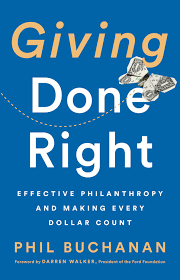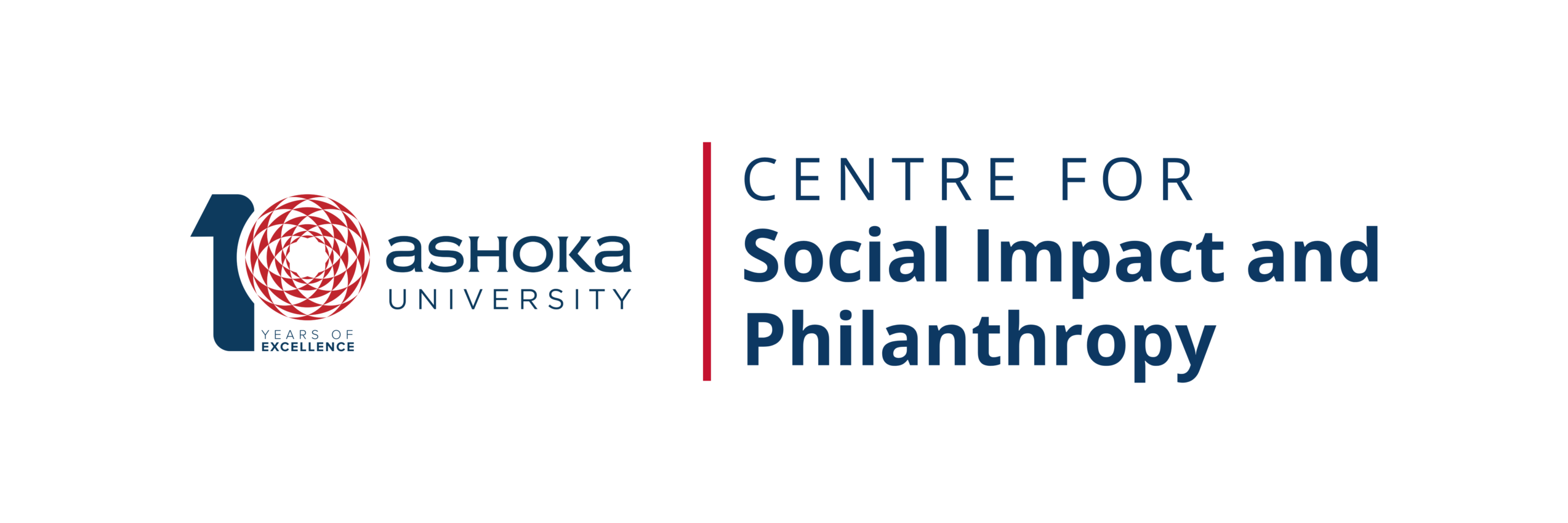


Giving Done Right: Effective Philanthropy and Making Every Dollar Count — by Phil Buchanan
Giving Done Right: Effective Philanthropy and Making Every Dollar Count, by Phil Buchanan. Public Affairs. New York, 2019; 256 pp: ISBN 9781541742253
The act of giving is defined in deceptively simple terms by any dictionary: “to grant or bestow by formal action; to accord or yield to another; to put into the possession of another for his or her use.”[1] I think it is fair to say that most of us do not think deeply about the meaning of the act of giving. It is a familiar action that happens every day in multiple ways and among multiple entities. One of the merits of this excellent new book about giving, by Center for Effective Philanthropy (CEP) President Phil Buchanan, is that it engages the reader in a deeper reflection on what may seem on the surface a simple act. Giving isn’t simple. Indeed, reflection demonstrates how much there is under the surface. Giving involves both heart and mind. It can be spontaneous and generous. But it can also be calculated or deceitful. It can be altruistic or selfish. It can create trust or establish dominance. It can be about equality. Or it can be about power.
Buchanan has been working with givers for close to 20 years. His platform has been the CEP, a research and consulting non-profit organization of which he is the founding president. CEP provides data and insights to what it calls “philanthropic funders” with the goal of increasing their effectiveness and impact. In practice, this means that CEP works most closely with institutional givers, or grantmaking foundations. Over the years, Buchanan has interacted with hundreds of these givers, which allows him a unique perspective on the work of giving. Indeed, there are relatively few vantage points such as the CEP in the United States and even fewer in Canada outside of the intermediary organizations such as Philanthropic Foundations Canada (PFC), which support the field of organized philanthropy and foundations.
People with specialized expertise in philanthropy are more apt to be found in the world of soliciting gifts than the world of giving gifts. So when a professional observer of giving such as Buchanan shares his reflections, it is an important and noteworthy contribution to the field.
In Buchanan’s view, “giving is a challenge like no other.” Again, this might surprise those who engage in spontaneous or regular giving. But his targeted audience is the giver – individual, household or foundation – prone to wonder about whether the gift is making a difference. In other words, if the gift is effective. This immediately narrows the meaning of gift from the general definition (a thing given willingly to someone without payment) or the legalistic definition (“a voluntary transfer of property without valuable consideration”[2]). Buchanan is interested in a form of “payment” on the gift. It’s the reward of effectiveness, of knowing that the gift is producing results of some kind. The effective giver derives satisfaction from giving “done right.” This doesn’t presume that the results are always going to be positive or expected. But the giver will be engaged in the giving, because the impact is as important as the act of giving itself. This type of giving goes beyond the giving that is either purely altruistic and anonymous, or that is done for a reward of recognition or status enhancement.
Of course, being effective as a giver is a personal choice, as Buchanan acknowledges. But he suggests that the most compelling reason to try to give “well” is the moral imperative to do the most possible good with the resources with which givers are entrusted (p. 50). This is particularly true for givers who have received a tax advantage for their gift, as almost all charitable foundations and many individual givers do. Ideally, the investment of the state in creating a public benefit through private giving is paid back through the efforts made by givers to give effectively. The benefit that these givers receive at the outset creates the dynamic that leads to a moral responsibility to give responsibly and well.
So what exactly is meant by giving done “right?” Buchanan uses a simple (and therefore memorable) framework to outline his approach to effective giving. The elements are straightforward: clear goals; coherent strategies; disciplined implementation; and good performance indicators. These elements are not unique to giving, but they can be difficult to apply. Buchanan adds that effective giving requires commitment, humility, patience, a willingness to understand the organizations and people to whom you give, and a sincere willingness to listen to, and work with, others. As he says, there is no shortcut. The effective giver “must learn and practice to become good (p. 9).”
In effect, Buchanan provides a handbook to walk the giver through the elements of an approach based on effectiveness. A chapter is devoted to each of the four elements he outlines. Examples of practice are freely shared, based on real cases of givers (individuals or foundations) with whom Buchanan has spoken. His advice is practical and based on experience. And he provides a thoughtful summary of his key guidance and advice at the end of each chapter. While the examples are all drawn from a US context, many of the situations and decisions would be equally relevant to givers outside the US. The book thus functions as both a thoughtful reflection on the meaning of effective giving and as a pragmatic guide for a non-professional giver. This is a rare combination.
On the matter of how to choose clear goals, which is one of the most frequently asked questions by givers who want to be effective, Buchanan has shrewd advice: choose some, just a few, and be realistic about what you can achieve and how you play your role. As he says, this choice of giving goals matters. “Everything that follows – the choice of strategies, how you work with nonprofits, how you assess results, what to do beyond giving to complement those efforts – depends on having clear goals (p. 81).” Luckily, he provides some excellent questions to help think through the choices.
He provides equally clear and detailed guidance on the difficult tasks, including: of finding strategies that are likely to lead to progress against the goals; of selecting and working with community partners; and, of measuring performance – of both the giver and the recipient. Buchanan repeatedly acknowledges that these are no easy tasks. He also emphasizes that the effective application of philanthropic dollars is not easily assessed. His message is that it is nevertheless possible to achieve this greater effectiveness, with effort and deep humility and understanding of context and a trusting commitment to non-profit partners.
Some common threads run through the book, which reveal Buchanan’s stance on some of the big questions in current debates in the world of professional philanthropy.
- Should philanthropy and giving be more like business? Buchanan’s answer is unequivocal: no. In his view, the language and drivers of business, such as consumers and investors, winners and losers, competition, secrecy of strategy, and cost per unit analysis, are antithetical to effective giving. Discipline and strategy are important. But so are collaboration, transparency, and long-term horizons.
- Can philanthropy truly address inequality or is it just a game for elites? Is there a case to be made against giving public subsidy to private giving? Buchanan’s answer is that foundations and individual givers play an important role that the state cannot. They can take on issues and make positive advances that benefit the public in ways that governments can’t (at least not alone). Buchanan cites public health campaigns, innovations in agriculture and health research, progress on human rights, and strengthened civic engagement as instances where foundations played a unique and productive role, in collaboration with community leaders.
- Can more impact be achieved by directing philanthropic assets to impact investing or to social enterprise and social innovation? Is giving in fact irrelevant? Buchanan clearly does not believe this. While he acknowledges that alternative strategies such as impact investing are valuable complements to giving, he argues that they cannot and must not replace giving. The non-profit sector has a unique and important role to play in addressing issues and solving human problems that markets and governments cannot. And effective giving, especially long-term and unrestricted giving, is a way to provide the necessary and sustained support.
I finished this book with real gratitude for Buchanan’s commitment to making the case for giving well and effectively. He has not sugarcoated the challenges. But his sensible and experienced voice is a much needed one in the field of philanthropy and he has provided an indispensable guide to givers who want to do the most possible good.
[1] https://www.merriam-webster.com/dictionary/give
[2] Canada Revenue Agency, “Gifts and Income Tax”, P-113, https://www.canada.ca/en/revenue-agency/services/forms-publications/publications/p113/p113-gifts-income-tax-2016.html
This book review was first published on The Philanthropist


